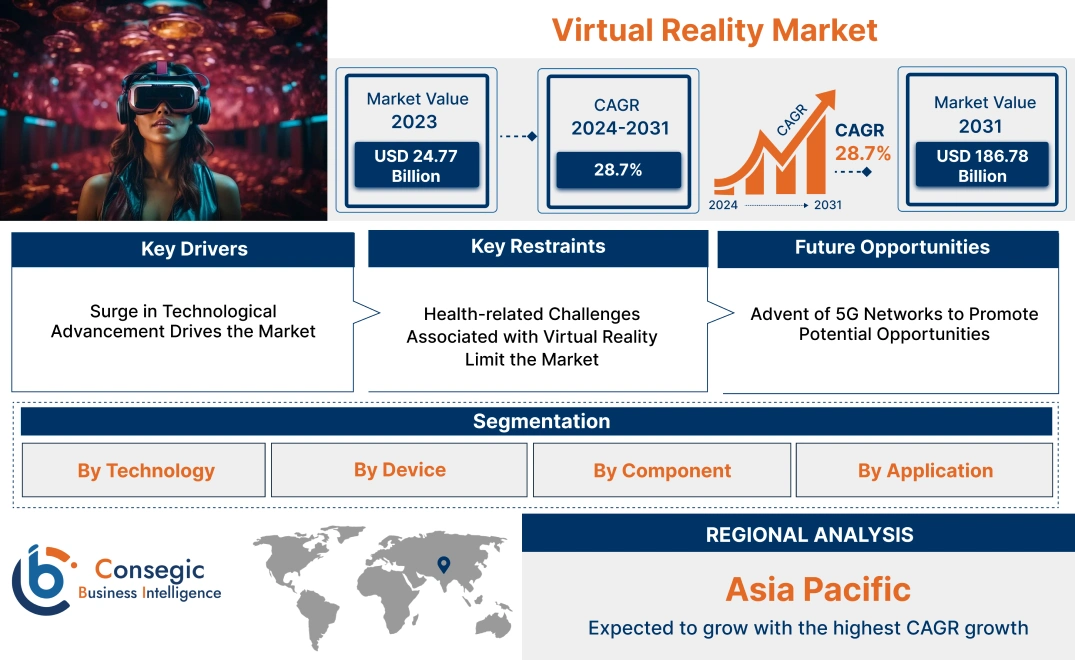- Summary
- Table Of Content
- Methodology
Virtual Reality Market Size:
Virtual Reality Market size is estimated to reach over USD 186.78 Billion by 2031 from a value of USD 24.77 Billion in 2023 and is projected to reach over USD 31.44 Billion in 2024, growing at a CAGR of 28.7% from 2024 to 2031.
Virtual Reality Market Scope & Overview:
Virtual reality refers to a near-eye display device that generates a simulation of any environment. This technology creates an immersive experience, giving the impression of physical presence within the simulated environment, which can be observed in a 360-degree view. It is versatile and can be used for distance education, games, surveys, healthcare, and others. Moreover, it offers a range of benefits including experiential learning, increased learner attention, a safe and controlled environment, and others.
For instance, in June 2023 Apple launched the Apple Vision Pro. It is a revolutionary spatial computer that could be used for work, collaboration, connection, reliving memories, and entertainment. Apple Vision Pro has features such as infinite canvas for productivity, ultimate entertainment experience, new gaming experiences, and more.
Virtual Reality Market Dynamics - (DRO) :
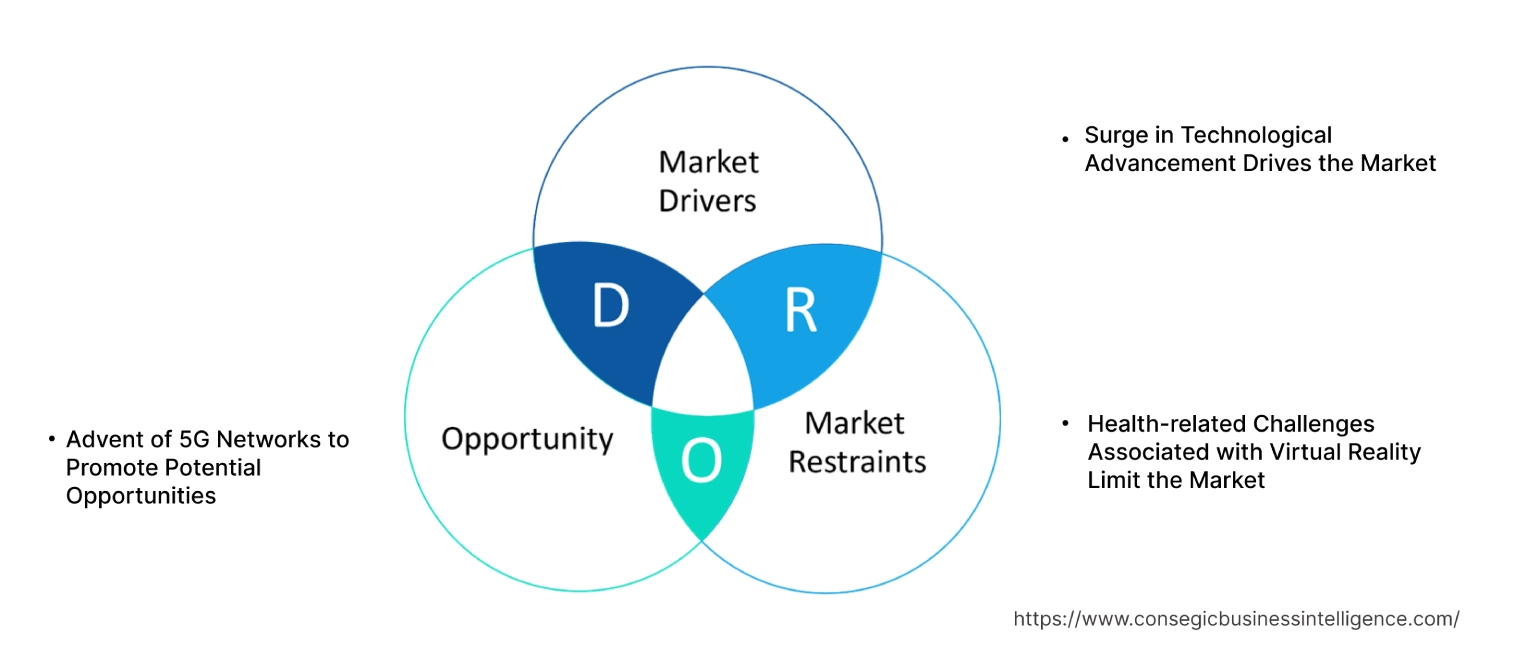
Key Drivers:
Surge in Technological Advancement Drives the Market
The virtual reality (VR) market is experiencing substantial growth, fueled by rapid technological advancements in both VR hardware and software. These developments are enhancing user accessibility and engagement, creating an immersive experience that appeals to a broader consumer audience. As hardware costs decrease and VR-compatible devices become more widespread, VR technology is becoming increasingly accessible across demographics. Furthermore, the adoption of VR in diverse sectors—including gaming, entertainment, education, healthcare, and enterprise training—is significantly expanding its market footprint.
- For instance, in January 2024, the World Health Organization (WHO) launched an innovative virtual reality (VR) tool for ship sanitation inspection. It was used for the first time during a four-day training session in Istanbul. This tool aims to increase health capacities in ports and on ships with an emphasis on the effects of the COVID-19 pandemic on the shipping industry. The VR tool allows users to conduct comprehensive sanitation inspections of ships, from engine rooms to cabins. It is one of the many capacity-building events for improving border health in WHO/Europe.
Thus, the market trends analysis shows that the continued innovation in VR technology is a key driver of the market, setting the stage for sustained expansion across various industries and consumer segments, and boosting the virtual reality market demand.
Key Restraints :
Health-related Challenges Associated with Virtual Reality Limit the Market
Health-related challenges are proving to be significant barriers to the virtual reality (VR) market. Issues such as motion sickness, eye strain from extended use, and other discomforts are common, impacting user experience and adoption rates. Additionally, high equipment costs, usability challenges, and a limited pool of VR expertise make effective implementation difficult for some organizations. The lack of personalization in VR applications further limits user engagement, while a knowledge gap regarding VR's potential value in specific applications restricts broader utilization.
Thus, addressing these health and usability constraints will be essential for VR technology to achieve wider acceptance and sustained growth across sectors, limiting the virtual reality market growth.
Future Opportunities :
Advent of 5G Networks to Promote Potential Opportunities
The implementation of 5G networks is poised to transform virtual reality (VR) experiences, delivering significantly faster data speeds and enhanced network reliability. These advancements are anticipated to reduce latency, improve graphical fidelity, and create more immersive, interactive environments, thereby elevating the overall quality and user experience in VR applications. The convergence of 5G and VR is expected to open new opportunities across various industries, underscoring its potential as a cornerstone for future digital experiences.
- For instance, in June 2023, a joint venture was announced by T-Mobile with Google Cloud, where the two companies would collaborate to combine 5G Advanced Network Solutions with Google's powerful edge computing abilities. The project's goal is for companies to provide brand new services to customers, as well as experimentation in some of the most promising connected areas possible like AR/ VR experience.
Therefore, market trends depict that the integration of 5G with VR represents a promising development for the VR market, setting the stage for substantial growth and enhanced user engagement in the digital ecosystem, and creating virtual reality market opportunities.
Virtual Reality Market Segmental Analysis :
By Technology:
Based on the technology, the market is classified into fully immersive, semi-immersive, non-immersive, augmented, and collaborative VR.
The fully immersive segment accounted for the largest revenue share of the total virtual reality market share in 2023.
- A fully immersive VR device is a gadget that ensures total engagement by stimulating all neural senses, creating the illusion of being in a different environment.
- Moreover, fully immersive VR offers a range of benefits including enhanced engagement, improved cognitive processing, and potential applications in healthcare.
- For instance, In May 2024, Sandbox VR, a premium destination for VR experiences, partnered with Apparel Group, the fashion and lifestyle retailing global leader. This franchise partnership is intended to bring the latest virtual reality technology to the Middle East since it intends to open 25 establishments by the end of 2028. They are taking advantage of a collaboration between Apparel Group and its 2,200 stores within 14 countries and 85 brands under its name through this cooperation.
- Thus, as per the segmental trends analysis, the fully immersive VR segment leads the market due to its advanced sensory engagement capabilities and wide-ranging applications, positioning it as a critical driver of the VR industry, proliferating the virtual reality market demand.
The semi-immersive segment is anticipated to register a significant CAGR during the forecast period.
- It is a gadget that enables simultaneous interaction between virtual and real-world environments.
- It blends the light from the physical world with virtual light, resulting in a coexistent experience during usage.
- Moreover, the primary benefits of semi-immersive devices include a balance between realism and digital immersion, suitability for educational or training purposes, and easier implementation on existing equipment.
- For instance, in January 2024 Sony Corporation plans to develop an immersive spatial content creation system with a 4K OLED Microdisplay-fitted XR head-mounted display. It can run video see-through plus 3D interaction controllers for simulating an intuitive environment. The technologically advanced 3D content creators will be supported by the system in their work. Siemens, being an industrial firm will be the only company that will be partnered with at the time of introducing this new product.
- Therefore, the market trends analysis depicts that the semi-immersive segment is expected to experience a substantial rise due to its ability to offer a balanced integration of virtual and real-world elements, boosting the virtual reality market trends.
By Device:
Based on the device the market is segregated into head-mounted displays (HMD), gesture-tracking devices (GTD), and Projectors & Display Walls (PDW).
The head-mounted display (HMD) segment accounted for the largest revenue share of 59.04% in the year 2023.
- Factors including affordable HMDs, increased use of AR and VR devices, technological development, and increased digitalization as well as cheap microdisplays are key aspects driving the segment.
- Continuous improvements in display quality, comfort, and device functionality have enhanced user experiences, boosting adoption.
- Industries worldwide are adopting digital solutions, expanding the use of HMDs for training, simulation, and remote collaboration.
- For instance, in January 2023, Sharp Corporation developed a prototype for a lightweight VR head-mounted display that connects to smartphones and has a high resolution. In addition, it has an autofocus RGB color camera module that can run 120 Hz display refresh rates per second with 4K resolutions. The device has a display function that shows images from reality in color and a pop-up image function that displays reality in a separate VR space window. Furthermore, two B/W cameras for hand-tracking make up the headset so that it operates much more easily without controllers. Its lightweight design in addition to the compact size is another factor that contributes towards it being more fatigue resistant during prolonged use.
- The market trends show that the growth of the HMD segment is underpinned by affordability, expanding industry applications, and technological innovations, securing its dominant position and promising future potential within the VR market, driving the virtual reality market growth.
Gesture-tracking device (GTD) segment is expected to witness the fastest CAGR during the forecast period.
- Gesture-tracking devices (GTD) offer a range of features, including 3D object manipulation, real-time motion capture, and multi-touch recognition.
- Moreover, gesture-tracking devices (GTD) provide multiple benefits including enhanced user interaction, improved accessibility, and intuitive control in virtual environments.
- For instance, in May 2023, Ultraleap introduced the Leap Motion Controller 2, a second-generation hand-tracking camera that allows natural interaction with 3D digital content using hand movements. The upgraded controller features enhanced cameras with higher resolution and a broader angle, yet it consumes 25% less power. All these advancements are housed in a design that is 30% smaller for optimal fit. The Leap Motion Controller 2, Ultraleap's most versatile camera, is compatible with various platforms and devices, including virtual reality (VR), mixed reality (MR), augmented reality (AR) headsets, personal computers, and holographic displays.
- Thus, gesture-tracking devices (GTD) enhance user interaction in virtual environments by enabling 3D object manipulation, real-time motion capture, and multi-touch recognition, boosting the virtual reality market trends.
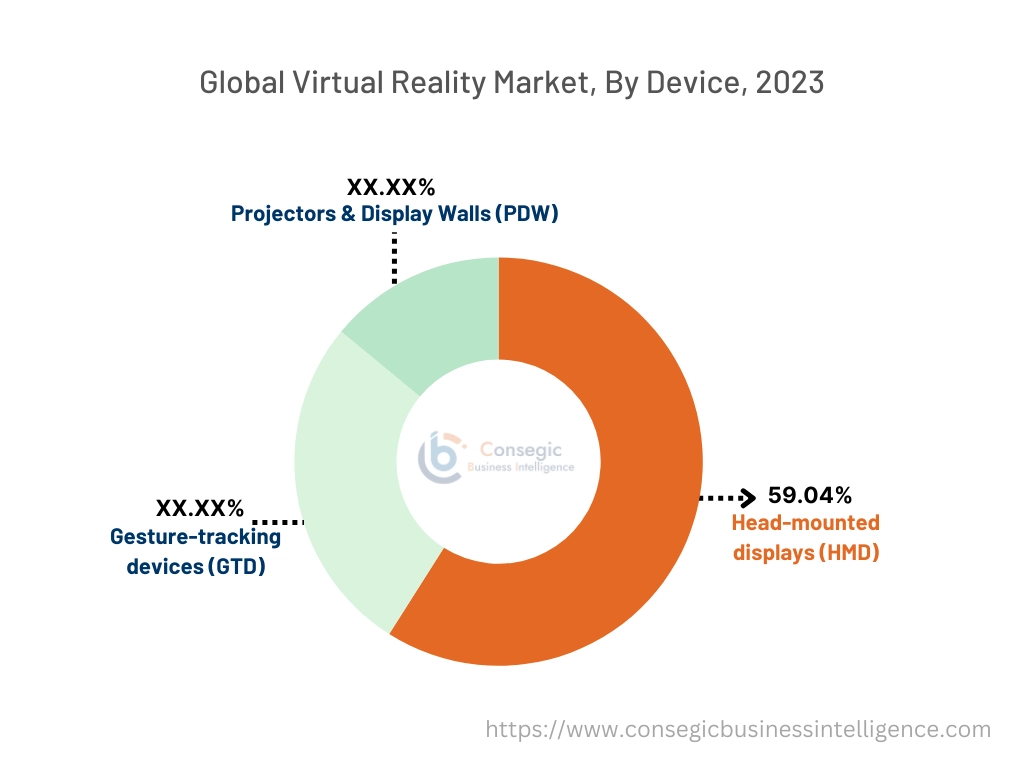
By Component:
Based on the component, the market is segregated into hardware and software.
The hardware segment accounted for the largest revenue share of the overall virtual reality market share in the year 2023.
- Rapid advancements in VR hardware—such as higher-resolution displays, enhanced tracking sensors, and improved processing capabilities—have significantly boosted demand.
- Increasing consumer interest in immersive experiences has accelerated the adoption of VR headsets, gesture-tracking devices, and other peripherals.
- Furthermore, the proliferation of faster internet connections, including 5G networks, is enhancing the performance of hardware devices by reducing latency, making VR experiences smoother and more responsive.
- As VR technology continues to advance, businesses across industries like gaming, healthcare, and training are incorporating VR hardware to improve engagement, training effectiveness, and operational efficiency.
- For instance, in April 2024 Meta is growing its VR universe by partnering with external hardware companies, such as iPhone and Android. The company intends to have many VR devices powered by its OS, versus Apple's closed system and by offering an alternative to the App Store, Meta is giving developers and users more flexibility, and that will drive innovation in the VR hardware space.
- Thus, the hardware segment is driven by technological improvements, growing consumer demand for immersive VR experiences, and infrastructure advancements, boosting the virtual reality market expansion.
The software segment is expected to witness the fastest CAGR during the forecast period.
- Significant advancements in VR software development tools, such as improved 3D modeling, animation, and interactive design capabilities, are enabling developers to push the boundaries of virtual environments.
- Additionally, the rise of cloud-based VR applications has opened new possibilities for content streaming, remote access, and collaboration, making VR more scalable and accessible for both consumers and enterprises.
- The adoption of VR software across various industries—ranging from gaming and entertainment to healthcare, education, and enterprise training—further underscores its potential for rapid rise as businesses seek advanced, interactive solutions.
- For instance, Trium Designs Company from India is dedicated to developing augmented and virtual reality (AR / VR) technology. They deal with consumer-oriented computer vision products that are aimed at enhancing human reality. Trium Designs has come up with a GPS-based AR display system that allows low-cost smartphones to show immersive AR and VR experiences without requiring any other hardware or software components as a way of making mixed reality more accessible.
- Therefore, the software segment is fueled by increasing demand for immersive virtual experiences, advances in VR development tools, and the shift toward cloud-based VR applications, creating lucrative virtual reality market opportunities.
By Application:
Based on the application, the market is segregated into gaming, entertainment, automotive, retail, healthcare, education, aerospace & defense, manufacturing, and others.
The gaming industry segment accounted for the largest revenue share in the year 2023.
- Factors including increased consumer interest in immersive gaming experiences, advancements in gaming technology, and the integration of VR in popular gaming platforms are key aspects driving the segment.
- For instance, in March 2024, the Premier League entered a four-year partnership with Rezzil, a Manchester-based virtual reality (VR) software developer known for creating sports gaming software. The goal of this community effort is to invent a VR game in which supporters can feel themselves on the field where they are playing together with the popular players of the Premier League.
- Thus, the gaming industry segment leads the VR market, driven by rising consumer demand for immersive experiences, continuous advancements in gaming technology, and the integration of VR into mainstream gaming platforms, boosting the virtual reality market expansion.
The healthcare segment is expected to witness the fastest CAGR during the forecast period.
- Factors influencing the use of VR in the healthcare segment, include increased adoption of telemedicine and advancements in medical imaging technology.
- Moreover, the use of VR in healthcare provides multiple benefits including improved surgical planning and training and effective pain management.
- For instance, in April 2024, the FDA's Center for Devices and Radiological Health (CDRH) partnered with an architectural firm specializing in futuristic, health-friendly, and all-inclusive design ideas. The collaboration intends for a hub capable of accommodating various types of home models such that they grow in complexity and scalability. This hub will be an Augmented Reality/Virtual Reality (AR/VR)-enabled home prototype.
- Therefore, as per the virtual reality market analysis, the healthcare segment is set to experience the fastest growth within the VR market, driven by the rising adoption of telemedicine, advancements in medical imaging, and the enhanced capabilities VR brings to healthcare applications.
Regional Analysis:
The regional segment includes North America, Europe, Asia Pacific, the Middle East and Africa, and Latin America.
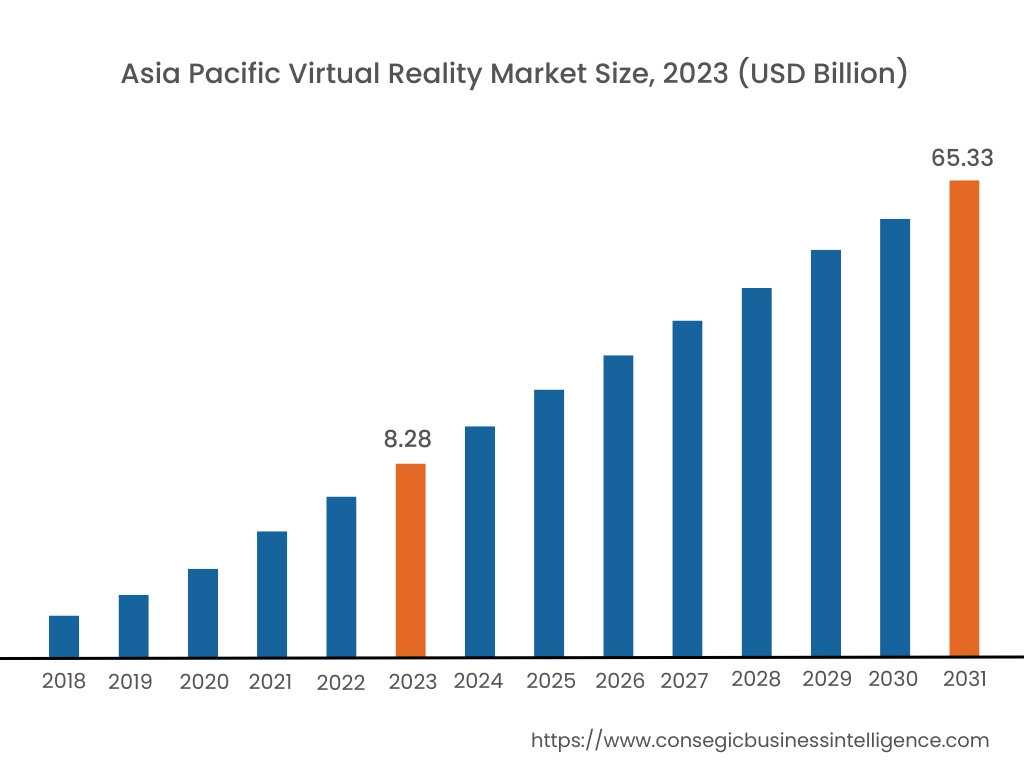
Asia Pacific region was valued at USD 8.28 Billion in 2023. Moreover, it is projected to grow by USD 10.55 Billion in 2024 and reach over USD 65.33 Billion by 2031. Out of this, China accounted for the maximum revenue of 34.4%. The technological advancements are providing lucrative growth prospects for the market in the region. In addition, factors including the launch of commercial 5G services in Japan enabling telecom providers to offer AR and VR viewing platforms, the expanding use of VR technology in various industries such as training for engineers, mechanics, pilots, and others are driving the market in the Asia Pacific region.
- For instance, in June 2022 the National Neuroscience Institute (NNI) of Singapore partnered up with Kyalio to come up with more than 100 virtual reality training modules specifically designed for neurosurgeons. This aims at filling the training vacuum further compounded by border closures that have seen doctors and medical students from Southeast Asia, South Asia, and Africa experience simulations of different neurosurgical processes. Involving operations such as craniotomies as well as tumor resections among many others, these modules are available through an Oculus headset or a mobile VR viewer. This innovative approach to training is expected to alleviate the shortage of experienced neurosurgeons and enhance hands-on experience among medical professionals.
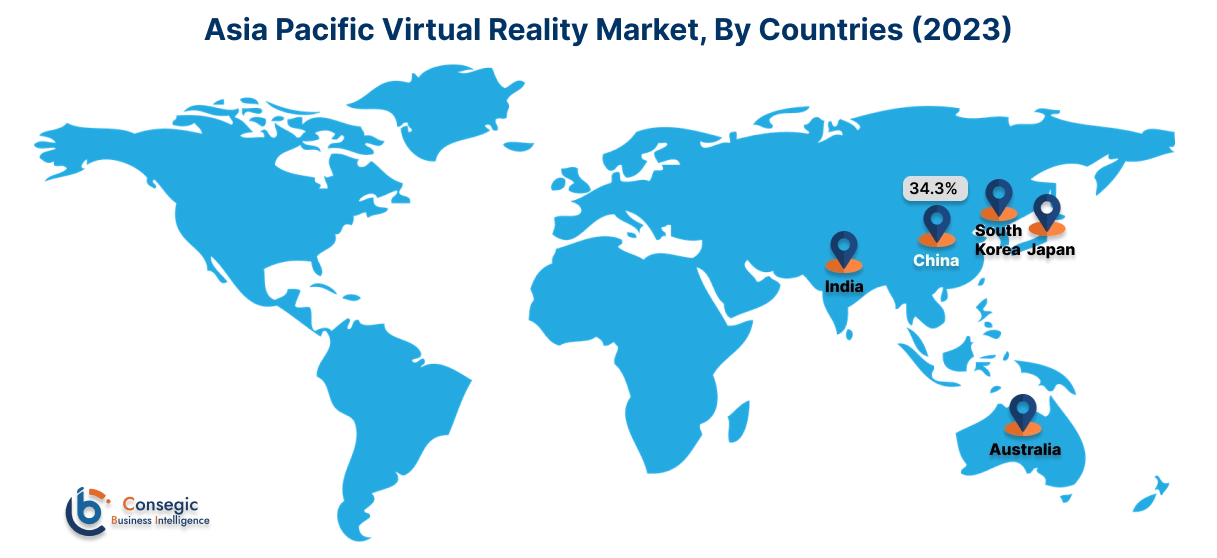
The regional trends analysis shows that the market in Europe is primarily driven by the prevalence of the vast gaming population in the region including widespread adoption of VR technology across various industries, particularly gaming and automotive. Moreover, the advent of improved graphics, new software platforms, and the reduction of bulky and pricey hardware has been a prevalent factor for market growth in the region.
- For instance, in December 2023, the European Commission launched the European Virtual Human Twins (VHTs) Initiative, a development that aligns with the inauguration of the MareNostrum5 supercomputer. The goal of this initiative is to speed up the adoption of VHTs in health and care for individualized health care by taking care of the current fragmentation within the VHT ecosystem in Europe.
Top Key Players & Market Share Insights:
The virtual reality market is highly competitive with major players providing products and services to the national and international markets. Key players are adopting several strategies in research and development (R&D), product innovation, and end-use launches to hold a strong position in the global virtual reality market. Key players in the virtual reality industry include-
- Microsoft Corporation (United States)
- HTC Corporation (Taiwan)
- Samsung Electronics Co., Ltd. (South Korea)
- Apple Inc. (United States)
- Meta Platforms, Inc. (United States)
- Google LLC (United States)
- Sony Corporation (Japan)
- Lenovo Group Limited (China)
- Unity Technologies Inc. (United States)
- NVIDIA Corporation (United States)
Recent Industry Developments :
- In April 2024, Metaverse911, an advisory firm in India specializing in the metaverse, inaugurated the Metaverse Experience Centre (MEC) in Noida. This facility is designed to cater to leaders in the field and individuals interested in Web3. Its purpose is to facilitate understanding of how immersive technologies like Augmented Reality (AR) and Virtual Reality (VR) can be instrumental in actualizing this digital world.
Virtual Reality Market Report Insights :
| Report Attributes | Report Details |
| Study Timeline | 2018-2031 |
| Market Size in 2031 | USD 186.78 Billion |
| CAGR (2024-2031) | 28.7% |
| By Technology |
|
| By Device |
|
| By Component |
|
| By Application |
|
| By Region |
|
| Key Players |
|
| North America | U.S. Canada Mexico |
| Europe | U.K. Germany France Spain Italy Russia Benelux Rest of Europe |
| APAC | China South Korea Japan India Australia ASEAN Rest of Asia-Pacific |
| Middle East and Africa | GCC Turkey South Africa Rest of MEA |
| LATAM | Brazil Argentina Chile Rest of LATAM |
| Report Coverage |
|
Key Questions Answered in the Report
How big is the Virtual Reality Market? +
In 2023, the Virtual Reality market was USD 24.77 Billion.
What will be the potential market valuation for the Virtual Reality by 2031? +
In 2031, the market size of Virtual Reality is expected to reach USD 186.78 Billion.
What are the segments covered in the Virtual Reality market report? +
Their technology, devices, components, and applications are the segments covered in this report.
Who are the major players in the Virtual Reality market? +
Microsoft Corporation (United States), HTC Corporation (Taiwan), Samsung Electronics Co., Ltd. (South Korea), Apple Inc. (United States), Meta Platforms, Inc. (United States), Google LLC (United States), Sony Corporation (Japan), Lenovo Group Limited (China), Unity Technologies Inc. (United States), NVIDIA Corporation (United States) are the major players in the Virtual Reality market.
